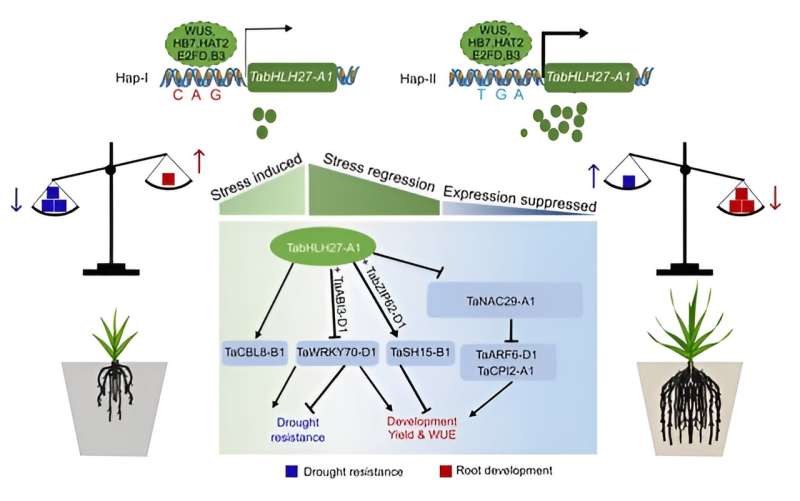This article has been reviewed according to Science X's editorial process and policies. Editors have highlighted the following attributes while ensuring the content's credibility:
fact-checked
trusted source
proofread
Researchers unlock water-saving potential of wheat with TabHLH27 balancing stress and growth

Wheat plays a critical role in global food security, but water scarcity in arid and semi-arid regions hinders its efficient production, suggesting significant opportunities for water saving. Therefore, understanding the genes that control wheat's drought tolerance and water use efficiency is critical for improving genetic resilience and breeding water-efficient varieties.
In a recent study led by Prof. Xiao Jun from the Institute of Genetics and Developmental Biology (IGDB) of the Chinese Academy of Sciences, researchers have shown how TabHLH27, a promising quantitative trait locus candidate for both relative root dry weight and spikelet number per spike in wheat, enhances wheat's drought tolerance and water use efficiency by balancing stress and growth.
The study, published in Journal of Integrative Plant Biology, sheds light on the multifaceted regulation of TabHLH27.
The researchers identified a shared genetic locus associated with drought tolerance at both the seedling and mature stages, pinpointing TabHLH27-A1 as a key candidate through expression profile analysis. Knocking out TabHLH27 significantly reduced wheat drought tolerance, spikelet number per spike, grain yield, and water use efficiency.
The role of TabHLH27 involves dual transcriptional activity, activating stress response genes while repressing developmental genes, possibly through interactions with co-factors like TabZIP62-D1 and TaABI3-D1. Its dynamic expression under drought stress, rapidly induced but declining over time, suggests a nuanced response for enhanced adaptation. Interaction with transcription factors like TaNAC29-A1 forms a hierarchical regulatory network crucial for wheat's response to water-limited environments.
In addition, natural variation in the TabHLH27-A1 promoter region affected its transcriptional response to drought stress, with the TabHLH27-A1Hap-II haplotype exhibiting superior drought tolerance, larger roots, higher yield, and water use efficiency.
TabHLH27-A1 alleles' distribution in China correlates with rainfall, favoring the superior TabHLH27-A1Hap-II in breeding due to its low frequency in modern varieties, indicating strong breeding potential. Backcrossing the superior haplotype into major wheat varieties improved drought tolerance, yield, and water use efficiency.
This study elucidates the molecular mechanism of TabHLH27 regulating drought tolerance and water use efficiency in wheat, deepens our understanding of wheat's response to drought stress and stress-growth balance, and provides essential genetic resources and selection targets for breeding drought-resistant, water-saving, high-yielding wheat varieties.
More information: Dongzhi Wang et al, TabHLH27 orchestrates root growth and drought tolerance to enhance water use efficiency in wheat, Journal of Integrative Plant Biology (2024). DOI: 10.1111/jipb.13670
Provided by Chinese Academy of Sciences





















